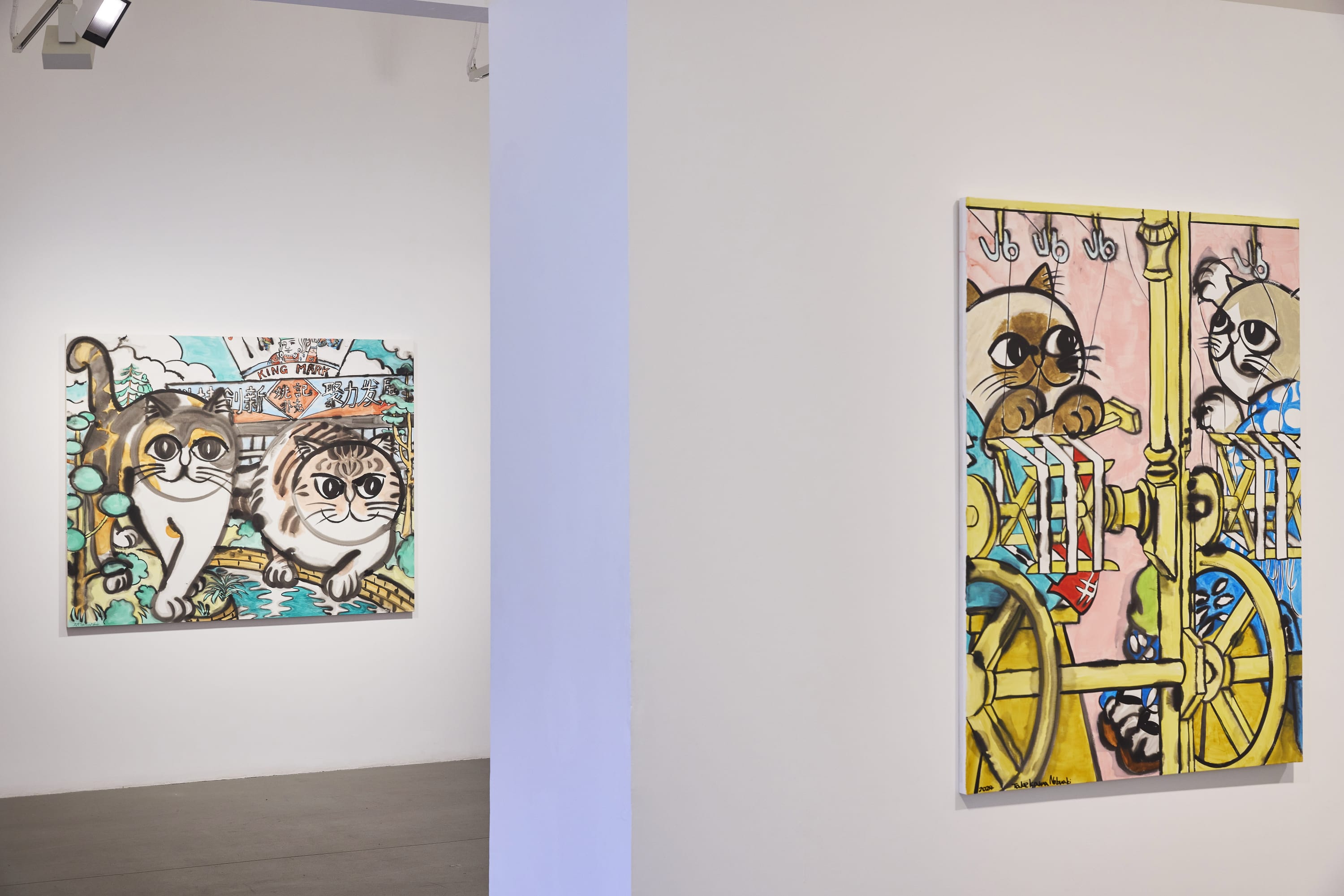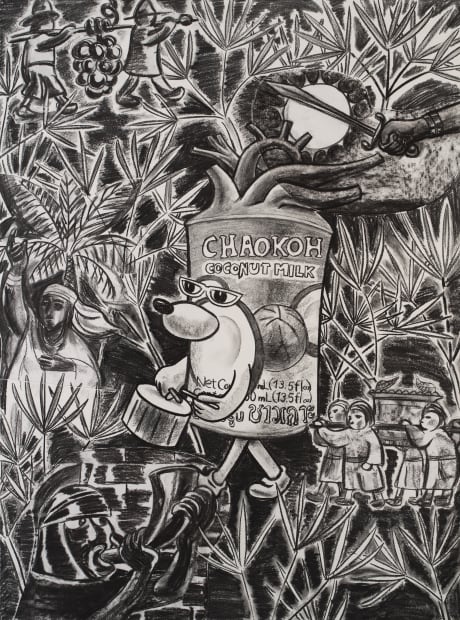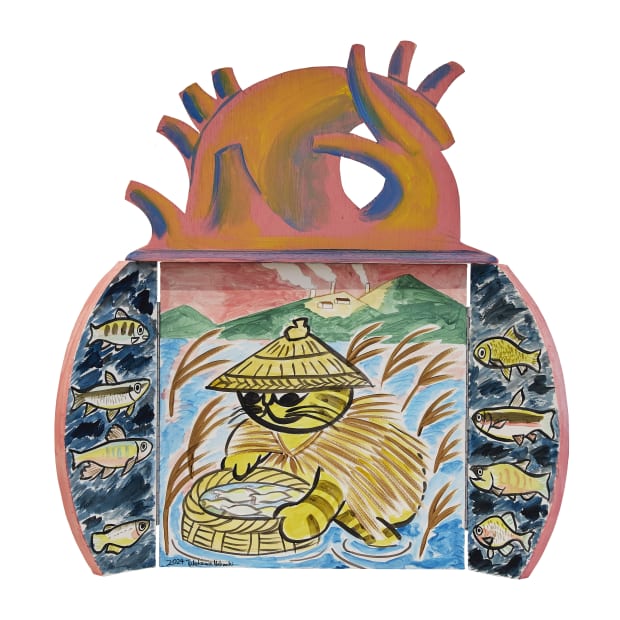-
In Japan, the idiom "水に流す" (flush with water) means to pretend that the past never happened. History, radiation, and everything else is being washed away.
However, history and personal experiences that should not be forgotten/ cannot be forgotten must be recorded. This exhibition presents the caricatures that I have painted, with this in mind.
— Nobuaki Takekawa
-
Ota Fine Arts Singapore is delighted to present "Flush with Water", a solo exhibition by Japanese artist Nobuaki Takekawa (b. 1977, Japan). This exhibition is a survey of Takekawa's artistic footsteps following his 2011 solo exhibition that looked into the Fukushima Daiichi Nuclear Power Station Accident. Since then, Takekawa has actively participated in the new wave of civic movements that have emerged from anti-nuclear demonstrations in Japan. Featured in this exhibition are Cat and Heart motifs which play important roles in unpacking the themes and historical narratives explored by the artist.
-
THE CAT MOTIFS
-

-
Takekawa has come to be known for the cat motifs in his work, which, under their adorable expressions, explore social issues of today and the past. Takekawa's solo exhibition "Cat Olympics" presented in our Shanghai (2017) and Singapore (2018) galleries looked at the similarities between the Berlin Olympics held under the Nazi regime and the 2020 Tokyo Olympics. By representing such serious themes through the motifs of cats, Takekawa is able to reassess these issues objectively. In this exhibition, the cats are painted in scenes that look at the major strains in society that have been created during the course of scientific and technological development and rapid modernization, such as the Fukushima Daiichi Nuclear Power Station issue, and the Ashio Copper Mine poisoning incident.
While the Fukushima Daiichi Nuclear Power Plant started discharging ALPS-treated water to the sea in 2023, so far it has not even been able to remove a single gram of nuclear fuel debris. Considering the huge human and economic burden, the attempt to extract 1g of debris can be compared to a mining operation. This led Takekawa to develop a focus on mining issues following the nuclear accident, given that mining has been at the heart of modernisation since the Industrial Revolution. It was also an issue that was related to many strains created by modernisation, such as imperialism, pollution and civil movements, forced labour and historical revisionism - themes that Takekawa has always been interested in.
-
 Nobuaki Takekawa, Cat's Ashio Copper Mine – Minecart, 2024, Acrylic on canvas, 162 x 194 cm
Nobuaki Takekawa, Cat's Ashio Copper Mine – Minecart, 2024, Acrylic on canvas, 162 x 194 cmAshio Copper Mine - Minecart (2024) depicts a model of the Ashio Copper Mine's touring facilities. The cats do not express the harshness of mining on their faces, but rather look as if they are enjoying their work. This discrepancy between reality and the imagined scenario is consistently portrayed in Takekawa's works, and further emphasised in this painting. While the Ashio Copper Mine contributed significantly to Japan's modernisation, it also created devastating social problems that gave rise to civil movements which continue to exist in modern-day Japan. The mining of copper brought about the development of smelting technology, electricity required for smelting and transportation of materials. Yet, on the flip side is the harsh forced labour of Korean and Chinese labourers from the colonies, which is not fully documented in Japanese national history.
-

Nobuaki Takekawa, Direct Appeal to the Emperor on the Issue of Mineral Poisoning, 2024, Acrylic on canvas, 130.3 x 162 cm
-
Apart from the establishment of heavy industries like the Ashio Copper Mine, the process of industrial modernisation was also a preliminary step to the development of light industries. The following eight artworks refer to various historical moments in Japan during this time.
-
-

Nobuaki Takekawa, Cat Hydroelectric Power Plant, 2024, Ink, acrylic on paper mounted on wooden board, 130.3 x 97 cm
As a result of the Ashio Copper Mine project, various enterprises were set up and remain to this day. In Cat Hydroelectric Power Plant (2024), a cat engineer is fixing a hydroelectric power station that was used to supply electricity to the copper mine. This was seen as the starting point for the development of many electricity-related businesses.
-

Nobuaki Takekawa, Dam that Imitates American Technology, 2024, Ink, acrylic on paper mounted on wooden board, 130.3 x 97 cm
With the development of hydropower, the latest dam technology was also introduced from abroad. The dam depicted here is modelled on the Toyotoshi Pond Dam. It was used for agricultural purposes and incorporated the multi-arch type, seen as the latest technology in the US at the time.
-

Nobuaki Takekawa, Electric Locomotive For Mining, 2024, Ink, acrylic on paper mounted on wooden board, 130.3 x 97 cm
Another technology that was imported from the US and Europe was the development of electric locomotives which were preferred to steam locomotives in the mines. Electric Locomotive For Mining (2024) depicts two cats operating an electrically powered train within the mining sites.
-

Nobuaki Takekawa, Cat Brick Factory, 2024, Ink, acrylic on paper mounted on wooden board, 130.3 x 97 cm
Modernisation saw the introduction of Western architecture in Japan, which led led to the growing demand for bricks. Near the Yanaka Lake, bricks were mass-produced in German-style kilns such as the Former Shimotsuke Brick Manufacturing Kiln depicted here (now a modern heritage site), and supplied to the Tokyo area by water transport downstream. The Yanaka Lake was also used to dam up the Ashio mineral poison.
-

Nobuaki Takekawa, Work to Earn Your Own Money, 2024, Ink, acrylic on paper mounted on wooden board, 130.3 x 97 cm
Before the establishment of heavy industries such as the Ashio Copper Mine, light industries were introduced as part of industrial modernisation. Work to Earn Your Own Money (2024) depicts two female cats employed in a silk factory, which was seen seen as a valuable source of cash income for women at the time.
-

Nobuaki Takekawa, Imported Paper Machine, 2024, Ink, acrylic on paper mounted on wooden board, 130.3 x 97 cm
With the success of the silk industry, Japan started to focus on the paper industry. Paper production was seen as an important industry for catching up with the international powers in terms of the production of intelligence. The technological advancements in such factories became the foundation for Japan's heavy industry in the lead-up to the Russo-Japanese War.
-

Nobuaki Takekawa, Dairy Farmers who Campaigned Against Mineral Poisoning, 2024, Ink, acrylic on paper mounted on wooden board, 130.3 x 97 cm
As a result of the direct appeal of activist Shozo Tanaka, the Mineral Poisoning Incident was covered in the newspapers, which led to the rise of student movements. Kurosawa Torizo (founder of Snow Brand Milk Products), who was 16 years old at the time, visited Tanaka and campaigned against mineral poisoning for four years. He then moved to Hokkaido and lived in the world of dairy farming under the ideological influence of Tanaka.
-

Nobuaki Takekawa, Hawaiian Hot Spring in A Coal Mining Town, 2024, Ink, acrylic on paper mounted on wooden board, 130.3 x 97 cm
Interestingly, the Joban Coal Mine is closely associated with the Ashio Copper Mine and Fukushima Daiichi Nuclear Power Plant. The Joban Coal Mine's Tankobushi (folk song) and the Ashio Copper Mine's Ashio Settobushi have similar lyrics, due to the interaction of miners, and the location of the Fukushima Daiichi Nuclear Power Plant was once the cultural area of the Joban Coal Mine. After the coal era ended, the town of Iwaki turned its main industry to hot springs, with the Yumoto Onsen water sourced from the Joban Coal Mine. Hawaiian Hot Spring in A Coal Mining Town (2024) is inspired by the story of the Joban Hawaiian Center, well known for not only its hot spring but also its dance troupe. This story was also adapted into a film, "Hula Girls".
-
-
THE HEART MOTIFS
-
 Nobuaki Takekawa, Thirteenth Year of Decommissioning Work, 2024, Acrylic on canvas, 181.8 x 227.3 cm
Nobuaki Takekawa, Thirteenth Year of Decommissioning Work, 2024, Acrylic on canvas, 181.8 x 227.3 cmMaking its exhibition debut is the character "Heart", marching in colourful costumes and beating drums. They were initially created after Takekawa was rushed to the hospital with a heart condition, coinciding with the period when undocumented foreigners died in Japan's detention centers without access to proper medical care. The incident triggered Takekawa to symbolise the heart of a regular citizen and the heart of a foreigner, an 'irregular' citizen. The Hearts stand against the social system of differential treatment based on ranking, and a lively tone exudes from the paintings and drawings. It is a beat that corresponds to the sound of the heart, as well as a beat that vibrates and echoes loudly, as if it were a declaration of their presence, in response to the power that ignores the existence of problems, and the weak as if they are not there. In the exhibition, we witness these Hearts striding through the gallery with a resounding demonstration of their existence.
-

Nobuaki Takekawa, Through the Reed-Rhapis Forest to Canaan, 2024, Charcoal on paper mounted on wooden board, 130.3 x 97 cm
-
STORYTELLING
-

-
Takekawa brings the storytelling element in his work a step further with these new 3-dimensional works, employing a format that is reminiscent of theatre or picture storytelling. The storyboard style also suggests that the scenes depicted in each piece is part of a larger narrative, and that the three scenes are connected. These works are also a combination of both the heart (through which he explores themes of the self and contemporary issues) and the cat motifs (relating to historical events).
-

Nobuaki Takekawa, Fishery and mineral poisoning, 2024, acrylic on paper mounted on wooden board, wood, 70.5 x 67 x 14 cm
-

Nobuaki Takekawa, Protecting the Village by Refusing Tax Payment and Military Service, 2024, Acrylic on paper mounted on wooden board, wood, 64.5 x 71 x 13 cm
-

Nobuaki Takekawa, Seeking a Meeting with the President of the House of Peers, 2024, Acrylic on paper mounted on wooden board, wood, 61.5 x 62 x 12 cm
-
ABOUT THE ARTIST
-

Past viewing_room
メーリングリストに登録
* denotes required fields
We will process the personal data you have supplied to communicate with you in accordance with our Privacy Policy. 登録が完了しました。.



















